|
< Earlier Kibitzing · PAGE 2 OF 2 ·
Later Kibitzing> |
| Nov-02-16 | | gofer: <BjarneNielsen: <dzechiel> how nice to see you back. I, for one, have missed you!> Agreed! Welcome Back! |
|
| Nov-02-16 | | patzer2: From the final position of the game, White wins after 27...Kf5 [] 28. Qe6+ Ke4 [28... Kg5 29. Qxe5+ Kg4 (29...Kh6 30. Bf8#) 30. h3+ Kh4 31. Be7+ g5 32. Qxg5#] 29. Qg4+ Kd3 30. Qxa4 (diagram below):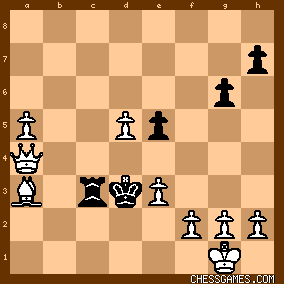
click for larger viewWith White a Queen up, the computer (Deep Fritz 15) indicates it's mate-in-eight for the first player. P.S.: The 26. Qe7+ continuation is more difficult (or at least longer) than the 26. Qe6+ line, but visualizing it is apparently no problem for a Super GM like Ivanchuk. |
|
| Nov-02-16 | | agb2002: White is a bishop and pawn ahead.
Black threatens Q(R)xa3.
White can start an attack against the black king with 25.Rxf7+: A) 25... Kxf7 26.Qe6+ Kg7 27.Qxe5+
A.1) 27... Kf7 28.Qe7+ Kg8 29.Qf8#.
A.2) 27... Kg8 28.Qb8+ (28.Qxc3 Qd1+ 29.Qe1 Qxe1#) and mate in three. A.3) 27... Kh6 28.Bf8#.
B) 25... Kg8 26.Rf8+ Kg7 27.Rg8+
B.1) 27... Kxg8 28.Qe6+ Kg7 (28... Kh8 29.Qf6+ Kg8 30.Qf8#) 29.Qxe5+ transposes to A. B.2) 27... Kf7 28.Qe6#.
B.3) 27... Kh6 28.Bf8+
B.3.a) 28... Kg5 29.h4+ eliminates the mate threat and keeps both the attack and material advantage. B.3.b) 28... Kh5 29.Qe2+ Qg4 (29... Kh4 30.Be7+ g5 31.Bxg5#; 29... Kg5 30.h4+ as above) 30.Qxg4+ Kxg4 31.h3+ + - [B+2P]. C) 25... Kh8 26.Qf6+ Kg8 27.Qg7#.
D) 25... Kh6 26.Bf8+
D.1) 26... Kg5 27.Qf6+
D.1.a) 27... Kg4 28.h3+ Kh5 29.Rxh7#.
D.1.b) 27... Kh5 28.Rxh7+ Kg4 29.Rh4# (or 29.h3#, 29.f3#). D.2) 26... Kh5 27.Qe2+ (27.Rxh7+ Kg5 28.Be7+ Kf5 (28... Kg4 29.Qe6#) 29.Qe6+ Ke4 30.Rh4+ Kd3 31.Rxa4 Rc1#) D.2.a) 27... Kg5 28.f4+ exf4 (28... Kh4 29.Rxh7#) 29.exf4+ wins. D.2.b) 27... Kh4 28.Be7+ g5 29.Rxh7#.
D.2.c) 27... Qg4 28.Rxh7+ Kg5 29.Be7+ Kf5 30.e4+ Kf4 (30... Qxe4 31.Rf7#) 31.Rf7+ Qf5 32.g3+ Rxg3+ 33.f(h)xg3#. |
|
| Nov-02-16 | | DIO: +3 <dzechiel>! Hopefully this is a sign for more frequent posts? :-) |
|
Nov-02-16
 | | Sally Simpson: The first post in this thread is one of the best jokes I've seen. After the lad's analysis he gets to here and suggests; 
click for larger view30.Qxc3.
Not only missing mate in one for White but after 30.Qxc3 Qd1+ it's White who gets mated. |
|
Nov-02-16
 | | Jimfromprovidence: I got 25 Rxf7+ Kg8 26 h3.
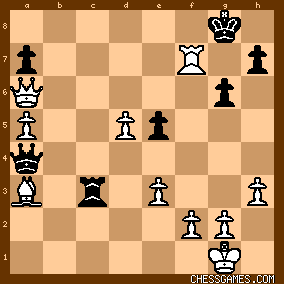
click for larger view If 26...Kxf7, then 27 Qe6+ leads to mate.
If either 26...Qxa3 or 26...Rxa3, then 27 Qf6 leads to mate. If 26...Qd1+ 27 Kh2 Qxd5, then 27 Rf8+, below, leads to mate. 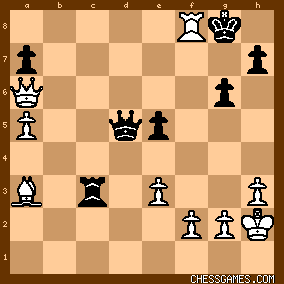
click for larger view |
|
| Nov-02-16 | | YouRang: Wednesday 25.?

click for larger view
Both sides have threats (and black's look more threatening), but white gets to move first. Given black's threats, I figured white would be looking for a move that (1) gives check, and (2) exposes black's king to further checks, and mate. This thinking makes <25.Rxf7+!> the obvious try, and it's not too hard to see that the rook is immune: <25...Kxf7? 26.Qe6+ Kg7 (forced) 27.Qxe5+ Kg8> (...Kh6? Bf8#; ...Kf7? Qe7+ & Qf8#) <28.Qb8+> (soon followed by ...Kg7 Qf8#). However, the king can't successfully run away either: - 25...Kh6 27. Bf8+ and the queen will join the attack with check via f6 or e2. - 25...Kg8 27.Rf8+ Kg7 28.Qf6+ Kh6
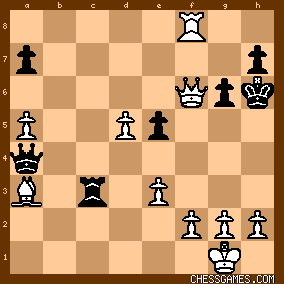
click for larger view
Now 29.h4! adds to white's attack while also defusing black's back-rank threat, leading to Qg5+, Qxe5+, Rg8 (threat Qg5#). |
|
| Nov-02-16 | | residencial master: I saw the better line mate in 4, after kxf7, Qg6+ and then kg7 - Qxe5+ = kg8 with Qb8+ the 2 square that the king have to go is mate Kf7 - Qf8#, Kg7 - Qf8# |
|
| Nov-02-16 | | YouRang: Ivanchuk's line with <26.Qxa7+> (rather than 26.Qe6+) is interesting, as the Qf8# threat looms immediately unless black plays <26...Kf6>. But in that case, the king is totally flushed out after <27.Qe7+>. The only little complication is that the king can run to e4: <27...Kf5 26.Qe6+ Ke4>
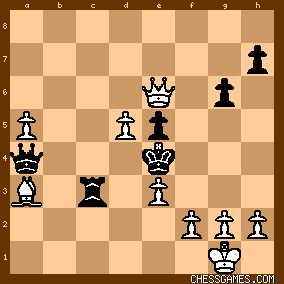
click for larger view
At this point, white has only one way to win: <29.Qg4+!> winning the Q with a skewer -- and mate won't be far behind. |
|
| Nov-02-16 | | kevin86: White's sac leads to a quick mate. |
|
| Nov-02-16 | | patzer2: Declining the Rook sacrifice 25. Rxf7+  is a tad complicated: is a tad complicated:<25. ♖xf7+ ♔h6> (25... Kg8 26. h3  with mate-in-ten to follow per Deep Fritz 15) with mate-in-ten to follow per Deep Fritz 15) <26. ♗f8+ ♔g5> (26... Kh5 27. Rxh7+ Kg5 28. Be7+ Kf5 29. e4+! Kxe4 30. Rh4+ Kxd5 31. Qd6#) <27. ♕f6+ ♔g4 28. f3+ ♔h5 29. ♖xh7#>. |
|
| Nov-02-16 | | saturn2: Black threatens mate in one and QxB.
White has to be quick: Rxf7 and then bishop and queen cooperate. 26 Qa(b)7+.
The black pieces are badly coordinated so there is no interponing to this check. |
|
| Nov-02-16 | | swclark25: <agree with YouRang, 26.Qe6 seems more direct after Rf7>
another complication, what if Black king runs to g5 rather than the skewer prone e4 (27...Kf5 28.Qe6+ Kg5) with g4 or h4 as next hideout? Either way White should be able to keep Black on the run. |
|
| Nov-02-16 | | saturn2: Correction: <Black threatens mate in one> Of course not. After ..Qd1 white has Qf1. |
|
| Nov-02-16 | | Castleinthesky: Got the move, but did not figure out the full mate. |
|
| Nov-02-16 | | YouRang: <swclark25><another complication, what if Black king runs to g5 rather than the skewer prone e4 (27...Kf5 28.Qe6+ Kg5) with g4 or h4 as next hideout? Either way White should be able to keep Black on the run.> The run to g5 is a short run over a high cliff :-) <27.Qe7+ Kf5 28.Qe6+ Kg5 29.Qxe5+>
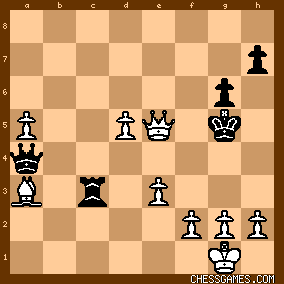
click for larger view
- 29...Kh6 30.Bf8#
- 29...Kh4 30.Be7+; Qg5# next.
- 29...Kg4 30.h3+ Kh4 31.Be7+ g5 Qxg5# |
|
| Nov-02-16 | | drollere: i liked the confidence in this sacrifice, given the black Q mating threat at d1, and the fact that the key piece (QB) is en prise. |
|
| Nov-02-16 | | NBZ: After 25...Kg8 27.Rf8+ Kg7 28.Qf6+ Kh6, it still seems tricky for white to win from here. For example, if 29. h4 (suggested by <YouRang>) Rxa3, we reach the following position: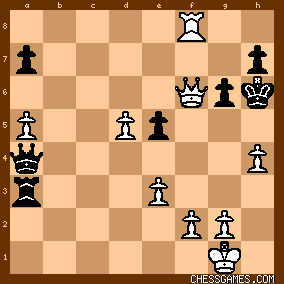
click for larger viewDespite the extra 2 pawns, this is not easy to win. Black has counter-attacking possibilities, the a-pawn is hanging and the king is not going to get mated. Instead, I think White could try, after 25. ... Kg8 26. Rf8+ Kg7 27. Rg8+! 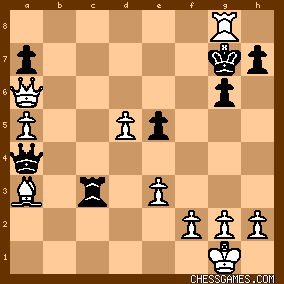
click for larger viewIf 27. ... Kxg8 White plays 28. Qe6+ Kg7 29. Qxe5+ and now
(i) 29. ... Kh6 30. Bf8#. (ii) 29. ... Kf7 30. Qe7+ and mate on f8 next move. (iii) 29. ... Kg8 30. Qb8+ and mate on f8 next move. If Black refuses the rook with 27. ... Kh6 28. Bf8+ Kg5 (Kh5 Qe2+) 29. h4+ wins easily. |
|
| Nov-02-16 | | NBZ: Looking back I realized that <agb2002> already found the Rg8+ idea :) |
|
| Nov-02-16 | | sfm: <NBZ: "Despite the extra 2 pawns, this is not easy to win. Black has counter-attacking possibilities, the a-pawn is hanging and the king is not going to get mated. ">
Actually, also here 30.Rg8 is a mighty good move. Threats are 31.Qg5# or 31.Rxg6+, hxR 32.Qh8#. On 30.-,Qg5 it's 31.Qg7+ and #. Black has only one free check. Must be over. |
|
| Nov-03-16 | | Moszkowski012273: Yeah 26.Qe6+... works much faster. |
|
| Nov-03-16 | | NBZ: <sfm> Nice analysis. 30. Rg8 is very strong. Sets up two mating threats and the only move that defends against both (Qg4) succumbs to a third mate. |
|
| Nov-03-16 | | YouRang: <sfm> Correct -- 30.Rg8 with 31.Qg5# is the threat, and black can do nothing about it. |
|
| Nov-03-16 | | izimbra: Fantasy continuation analysis dept: In the game text, Sutovsky blundered with <22...Rc3>. White had a significant advantage, before, but black was completely lost after that move. Suppose, then that black played correctly with <22..Qc2> then <23.Rf1 Qc4>...and now White has the choice of <24.Qxa7> or <24.Qxc4>. Which endgame to pick here? 
click for larger viewThe interesting point for me is that theory & Stockfish recommend Qxa7 as the choice giving better winning chances for White. But playing against itself, Stockfish only finds a winning plan after Qxc4. If <24.Qxa7 Qxd5 25.a6 Bf8 26.Bxf8 Kxf8> black ends up getting a blockade with R on a8, and White is not ultimately able to make progress. |
|
| Nov-04-16 | | ajiteshjaiswal: 26. Qe6+ Kg7
27. Qe5+
Also wins the game |
|
 |
|
< Earlier Kibitzing · PAGE 2 OF 2 ·
Later Kibitzing> |





